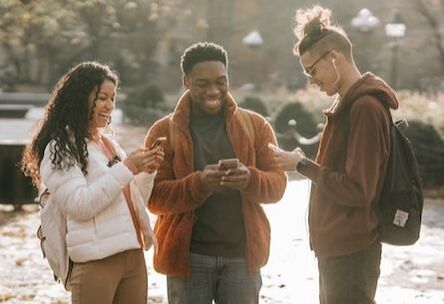|
According to the Bureau of Labor Statistics, only about one-third of businesses survive to their 10th year. We are thrilled here at Leading Tomorrow to have celebrated this milestone this past month! For the rest of this year, we will be highlighting key resources, providing new content, and having special offers to say “thank you” to those of you who have supported and worked with us over the past decade! This month, I reviewed my current Top-10 Picks for Next Gen Resources (see below). I hope you find these helpful! You can also listen to me discuss key takeaways from each resource in this month’s episode of The Leading Tomorrow podcast.
Marching Off the Map by Tim Elmore and Andrew McPeak This book was published in 2017 but continues to be my go-to resource for teaching and training strategies for Gen Z & Gen Alpha. My favorite is the EPIC model — experiential, participatory, image-rich, and connected (relational). This is how young people today learn best! Zconomy: How Gen Z Will Change the Future of Business—and What to Do About It by Jason Dorsey & Denise Villa This is the best book I have found on understanding the workplace expectations and needs of Gen Z. Practical strategies are presented for every step of onboarding a Gen Z team member, from recruiting, to training, to retention. The Culture Translator by Axis This weekly email on what is trending in culture and the lives of teens is gold. For example, did you know that in teen slang “Bop” means a really good song, “Cheugy” means awkward or cringey, and “Finna” means you are going to do something? Axis also has a podcast and many other resources for anyone wanting to understand the music, movies, shows and social media trends impacting today’s youth. Tech-Wise Family: Everyday Steps for Putting Technology in Its Proper Place by Andy Crouch and Amy Crouch My favorite all-around resource on creating a family/home culture that helps manage technology in healthy ways. A great quote from the book states: “Technology is in its proper place only when we use it with intention and care. If there’s one thing I’ve discovered about technology, it’s that it doesn’t stay in its proper place on its own; much like my children’s toys and stuffed creatures and minor treasures, it finds its way underfoot all over the house and all over our lives. If we aren’t intentional and careful, we’ll end up with a quite extraordinary mess.” Another convicting quote: “An awful lot of children have been competing with their parents’ screens for attention their whole lives.” Family Media Plan Tool by the American Academy of Pediatrics This tool walks parents and other family members through a practical list of questions to consider in creating a media plan for the young people in our lives. I appreciate how the template generates good considerations for how to help all of us manage our devices. The Anxious Generation: How the Rewiring of Childhood is Causing an Epidemic of Mental Illness by Jonathan Haidt This one was just released in March of 2024 and is already creating some powerful dialogue regarding how childhood has changed, what young people need, and how adults need to be intentional and unrelenting in creating environments for the next gen that counter the mental health epidemic and related challenges. Kids’ Brains and Screens: A ScreenStrong Student Course by Melanie Hempe Finally, a practical resource for educating and equipping young people to understand the impact of screens on their developing brains and lives. While most resources on technology speak to adults, this curriculum is designed for middle school students and presents information in a fun and engaging way. ScreenStrong has other resources as well. Generations: The Real Differences Between Gen Z, Millennials, Gen X, Boomers, and Silents - and What They Mean for America’s Future by Jean Twenge Dr. Jean Twenge is one of the most noted researchers on generational trends. In this, her latest book, she highlights key factors that contribute not only to the perspectives and behaviors of the youngest generations, but the trends that have impacted all of the living adult generations today. Touch the World Youth & Young Adult Mission Training and Trips Committed to equipping the next generation to live on mission every day, everywhere, Touch the World has some of the best training materials and programs out there for engaging Gen Z in missions. They offer in-person and online training, as well as short-term trips, internships, and a gap year program. Gen SeXYZ: Love, Sexuality and Youth by Jeff Grenell In the opening chapter, Grenell states: “One of the cultural realities of the Millennial and Gen Z sets is that they are living in a real and historic sexual revolution. Maybe the most staggering society-shifting tsunami to ever hit the shores of youth.” He continues to unpack the sexual revolution occurring today and offers practical strategies for anyone mentoring the next generation.
0 Comments
It is often noted today that our society and especially younger generations lack GRIT. So, what is GRIT? GRIT is a combination of passion and perseverance. It’s not necessarily strength, but rather the ability to persist in the face of challenges and setbacks, to always move forward. Sometimes, there are other words that are used interchangeably, like resilience, but GRIT and resilience are quite different. Resilience is the idea of learning from something, whereas GRIT is about continuing to move forward, no matter what.
GRIT is not something that we’re given, it’s not an intelligence that we have, It’s not a talent we’re born with. It’s a mindset and a skill set that must be cultivated; it’s something that must be grown. GRIT is a predicator of success, more than just natural ability. GRIT helps make long-term success happen. Embracing failure is key to developing this type of perseverance. Younger generations often need encouragement to view failure as a steppingstone to improvement. So, what are some indicators that young people in our lives need to develop GRIT? Here are a few indicators to consider:
Often, we can be prone to “rescue” young people around us from challenges or difficulties. We want to minimize their stress and struggle. However, offering consistent encouragement and support as they persist in working through challenges is a powerful gift that helps equip them to be successful. Below is a list of resources with more insights and tips for encouraging GRIT in the young people we lead, teach, mentor and parent. The excerpt above is from my most recent podcast interview with James LaLonde. Check it out the full conversation on our website, or wherever you listen to podcasts. A Growth Mindset for Teens by Sydney Sheppard Executive Functioning Workbook for Teens Grit for Kids by Lee David Daniels Grit: The Power of Passion and Perseverance by Angela Duckworth I was recently asked if I had ever developed a top 10 list of Gen Z traits. The following is not a comprehensive list, but these ten traits stand out to me as important for us as leaders, parents, teachers, and mentors to understand about the next generation.
The demographics of the workplace are changing. The U.S. Bureau of Labor Statistics indicates that by 2031, Millennials and Gen Z will make up three fourths of the labor force in America, with Millennials currently the largest generational block in the workplace. As young employees begin their careers and new generations step into management and leadership roles, it is important to understand how to engage and motivate individuals across generations.
Today, younger employees are more likely to want to interact with colleagues and leaders, to engage in discussion around important topics, and have permission to ask questions. Employees want to know they have a voice, that they belong and are valued in their organization. While fair compensation is important to all generations, younger employees are also motivated by their emotional needs being considered. Authentic relationships are important, as is understanding how different individual roles contribute to a greater purpose. Consider the following as you look to motivate different generations on your team:
 The oldest members of Gen Z (b. 1996-2010) are now young adults and many are looking for or starting new jobs. This is a generation that has carried smartphones in their back pocket since adolescence and they entered adulthood amid a pandemic. As a result, their expectations as they begin working with a team are often very different than previous generations. Organizations and leaders that want to equip and retain young team members benefit from understanding and responding to their expectations and supporting their needs. Dorsey and Villa's book, Zconomy: How Gen Z Will Change the Future of Business—and What to Do About It, offers some helpful insights on Gen Z in the workplace. Here are a few quick ideas to consider as you onboard young team members:
Check on this month’s episode of The Leading Tomorrow podcast for more on effective ways to onboard new Gen Z team members.  More and more Millennials are stepping into leadership and management positions. In many cases, they are overseeing various generations. Their teams can include Generation Z, now entering the workforce as college graduates, to Boomers, who are sometimes the age of their parents or even grandparents. This age diversity produces challenges for even experienced managers. For Millennial managers, often navigating their first supervisory role, it can produce stress and uncertainty. Here are a few reminders for Millennial managers as you learn and grow as a leader:
Healthy leadership requires incredible self-awareness, courage, and sacrifice. As a new manager or leader, you need support. Find a mentor or friend who can encourage you, help you process the situations you are navigating, and provide honest feedback. You’ve got this!  In one of my favorite leadership books, Team of Teams, the author Stanley McChrystal explains, “The models of organizational success that dominated the twentieth century have their roots in the industrial revolution and, simply put, the world has changed…being effective in today’s world is less a question of optimizing for a known (and relatively stable) set of variables than responsiveness to a constantly shifting environment.” Young people today intuitively understand that the world is constantly changing, and adaptability is often more important than efficiency. They want to work with leaders, teams, and organizations that are willing to respond and adapt. This is one of the reasons that innovation is essential to engage the next generation effectively. This month, Dave Raley, founder of Imago Consulting joins me on the podcast to discuss how we need to rethink innovation. The first step is addressing myths about innovation. For example, one myth is that innovation is something you do after you have your act together, and everything is dialed in. The reality is that innovation is best applied when things aren’t going well. Crisis is often the opportunity that drives sticky innovation. Another myth is that innovation is all about the new, bright, shiny object. The truth is that innovation is a disciplined process. Young leaders bring unique perspectives to teams and organizations looking to become more innovative. They are more likely to question assumptions and to challenge current ways of doing things. They also are motivated to understand the “why” behind what we do, and the innovation process requires us to have those conversations. Philosopher Eric Hoffer once said, “In a world of change, the learners shall inherit the earth, while the learned shall find themselves perfectly suited for a world that no longer exists.” Innovation requires us to remain in a posture of learning. At times, this can result in fatigue, but the benefits are significant. Without learning, we are unlikely to thrive in a world that requires innovation. Futurist Alvin Toffler said, “The illiterate of the twenty-first century will not be those who cannot read and write, but those who cannot learn, unlearn, and relearn.” As you consider rethinking innovation, consider the following:
 Engaging multiple generations in any context can be challenging, but within established teams and organizations there can be unique barriers to effectively adapting to new expectations and needs. In these contexts, leaders need to be aware of their own mindsets toward younger employees, team members, and clients. It is also important to consider what assumptions we might be making that could result in confusion for those we are hoping to engage and equip. Steve Moore, President of Growing Leaders once said, “When institutional activities last more than one generation of leadership, the assumptions behind those activities become invisible to the current membership.” What is considered “self-evident” to most senior leaders may not be apparent to many new employees or participants. In this month's episode of The Leading Tomorrow Podcast, I talked with Doug Harrison, Director of Strategy and Innovation at Mission Aviation Fellowship. We identified several key mindsets and action steps critical for leaders and organizations in effectively engaging the next generation. These include the following:
 The following is a guest contribution written by leadership coach Dr. Bethany Peters: Recent research shows us that coaching in the workplace has significant benefits: employees who are coached can experience increased productivity, enhanced clarity, a boost in confidence, and improved communication skills, among other benefits. But what is coaching, exactly? Sir John Whitmore, a leading contributor to the coaching profession, defined it as a process of “unlocking people’s potential to maximize their own performance.” Coaching is distinctly different from other professions such as mentoring, consulting, and therapy. Although all of these are valuable sources of support, coaching employs a more facilitative approach to:
What value does a coach approach have for supporting the next generation? More than ever, an engaging relationship with a manager is vitally important to retaining young adults. When a manager takes an intentional, personalized approach to promote growth and development in the workplace, that style of leadership is much more likely to generate loyalty and commitment from members of Generation Y and Z. The coach approach appeals to young adults with its focus on:
A coach approach is grounded in trust-filled relationships and characterized by a commitment to:
If you are interested in leveling up your coaching skills, and learning how to take a coach approach in your specific setting, consider doing it with a group of other leaders and influencers… Six Weeks to a Coach Approach is an interactive, group coaching program launching this September, facilitated by leadership coach Dr. Bethany Peters. Social Media: https://www.instagram.com/theleadershipcoachinglab/ https://www.linkedin.com/in/bethany-d-peters/  As we seek to engage Gen Z, the most diverse and global generation in history, we must continue to grow as multicultural leaders and organizations. I recently read a research study by international church planter, Mark McKinstry, that provided some powerful encouragement on multicultural leadership from the Bible. The following is an excerpt from Mark’s Thesis on how the leaders and church at Antioch modeled multicultural leadership: Musvosvi (2010) wrote, “The church at Antioch was as close to being a model as one gets in its ability to understand and constructively deal with multi-ethnic situations” (p. 48). If this is the case, what did the leadership and membership look like? Some of our best clues are found in the words of the Bible. Luke, the author of Acts, describes the leadership team of the Church of Antioch, “Now in the church at Antioch there were prophets and teachers: Barnabas, Simeon called Niger, Lucius of Cyrene, Manaen (who had been brought up with Herod the tetrarch) and Saul” (Acts 13:1). Based on this, we know the Antioch Church leadership team was formed out of a multi-cultural, multi-lingual, multi-class group of people. Barclay (1957) explains the diverse team further, Barnabas was a Jew from Cyprus; Lucius from Cyrene in North Africa; Simeon was also a Jew but his other name Niger is given and, since this is a Roman name, it shows that he must have moved in Roman circles; Manaen was a man with aristocratic connections, and Paul himself a Jew from Tarsus of Cilicia and a trained rabbi. (p. 115) Regarding the leadership team, Steel (2018) commented, Paul and Barnabas were both Jewish but had been raised outside Palestine. Both were fluent in Jewish language and customs, but they also spoke Aramaic and Greek. Then there’s Manaen, a man who grew up with incredible opportunity and education within the household of Herod Antipas. Next there’s Lucius of Cyrene, from North Africa, who may have been one of the initial evangelists who arrived amid persecution and began \ reaching out to Greeks. And last but not least was Simon called Niger, who was most likely a black African. (para. 12) The unity of this diverse leadership team became a powerful symbol to the membership of the church and to the city where they lived (Steel, 2018). Additionally, the membership of the Church of Antioch was a reflection of the leadership team. The members were made up of multiple cultures, language groups, ethnicities, and social classes. When I interviewed Mark on my podcast, I asked him what lessons leaders today can take from the life of Barnabas, one of the key leaders on the multicultural team in Antioch. He encouraged:
Good questions for each of us to ask ourselves include, “How am I actively engaging those who are different than me or who disagree with me?” “How can I embrace the discomfort and learning that can come with diversity?” “How am I developing and encouraging a multicultural team around me?” Barclay, W. (1957). The letters to the Philippians, Colossians, and Thessalonians. Westminster John Knox Press. Musvosvi, J. (2010). Race, ethnicity, and tribal conflicts. Journal of Adventist Mission Studies,6(1), Article 5. Steel, D. (2018, July 25). What the diverse Church in Antioch can teach us today. Retrieved from https://www.thegospelcoalition.org/article/diverse-church-antioch-teach-today/ |
AuthorDr. Jolene Erlacher is a wife, mommy, author, speaker, college instructor and coffee drinker who is passionate about empowering the next generation of leaders for effective service! Archives
May 2024
Categories
All
|

 RSS Feed
RSS Feed